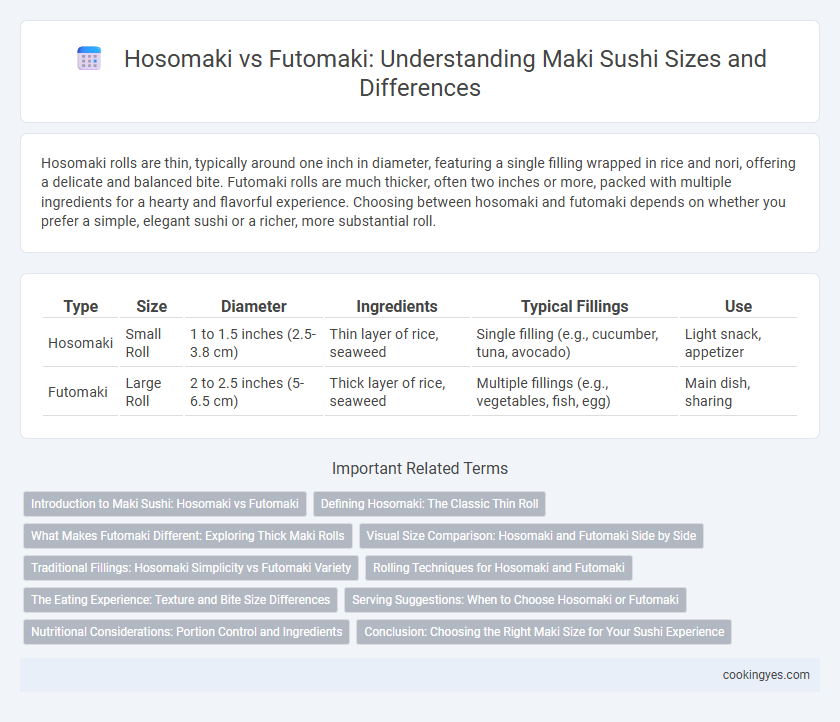Hosomaki rolls are thin, typically around one inch in diameter, featuring a single filling wrapped in rice and nori, offering a delicate and balanced bite. Futomaki rolls are much thicker, often two inches or more, packed with multiple ingredients for a hearty and flavorful experience. Choosing between hosomaki and futomaki depends on whether you prefer a simple, elegant sushi or a richer, more substantial roll.
Table of Comparison
| Type | Size | Diameter | Ingredients | Typical Fillings | Use |
|---|---|---|---|---|---|
| Hosomaki | Small Roll | 1 to 1.5 inches (2.5-3.8 cm) | Thin layer of rice, seaweed | Single filling (e.g., cucumber, tuna, avocado) | Light snack, appetizer |
| Futomaki | Large Roll | 2 to 2.5 inches (5-6.5 cm) | Thick layer of rice, seaweed | Multiple fillings (e.g., vegetables, fish, egg) | Main dish, sharing |
Introduction to Maki Sushi: Hosomaki vs Futomaki
Hosomaki and Futomaki are two popular types of maki sushi distinguished primarily by their size and ingredients. Hosomaki, known for its slim roll typically containing one main ingredient like cucumber or tuna, offers a light and subtle flavor profile. In contrast, Futomaki is a thicker roll packed with multiple fillings such as vegetables, fish, and egg, providing a richer and more complex taste experience.
Defining Hosomaki: The Classic Thin Roll
Hosomaki, known as the classic thin roll, typically measures about 1 inch in diameter and contains a single ingredient like cucumber, tuna, or salmon wrapped in nori and sushi rice. This minimalist style highlights the freshness and texture of the core filling while offering a delicate, balanced bite. In contrast, futomaki rolls are significantly larger, usually 2 inches or more, and feature multiple fillings for a richer, more complex flavor profile.
What Makes Futomaki Different: Exploring Thick Maki Rolls
Futomaki stands out with its larger size, typically measuring about 1.5 to 2 inches in diameter, compared to the slender hosomaki rolls that are usually around 1 inch wide. These thick maki rolls incorporate multiple ingredients such as vegetables, tamago, and seafood, creating a complex combination of flavors and textures. Futomaki's substantial width allows for a more filling experience and showcases elaborate, colorful fillings not found in the minimalist hosomaki.
Visual Size Comparison: Hosomaki and Futomaki Side by Side
Hosomaki rolls are thin, typically measuring around 1 to 1.5 inches in diameter, showcasing a minimalist aesthetic with a single filling wrapped in nori and rice. Futomaki rolls are noticeably larger, often exceeding 2 inches in diameter, packed with multiple ingredients, creating a visually bold and colorful contrast when placed side by side. This size difference highlights hosomaki's sleek, delicate presentation against futomaki's hearty, robust appearance in sushi platters.
Traditional Fillings: Hosomaki Simplicity vs Futomaki Variety
Hosomaki features thin rolls with a single traditional filling such as cucumber, tuna, or avocado, highlighting simplicity and clean flavors. Futomaki rolls are thicker and packed with a variety of ingredients like tamago, kanpyo, shiitake, and pickled vegetables, offering complex textures and tastes. Both types emphasize traditional Japanese flavors but differ significantly in size and ingredient diversity.
Rolling Techniques for Hosomaki and Futomaki
Hosomaki, characterized by its thin rolls typically containing one or two ingredients, requires precise rolling techniques using a bamboo mat to achieve tight, compact sushi. Futomaki involves larger, thicker rolls with multiple fillings, demanding careful layering and a firmer, more controlled roll to maintain structure and prevent fillings from spilling. Both techniques emphasize consistent pressure and even rolling to create the distinctive shapes and textures that define hosomaki and futomaki sushi.
The Eating Experience: Texture and Bite Size Differences
Hosomaki, characterized by its slender size, offers a delicate bite with a higher rice-to-filling ratio, creating a subtle texture that highlights individual ingredients. Futomaki, being thicker and larger, provides a more substantial mouthful, blending multiple fillings that create a complex, chewy texture and richer flavor profile. The size difference in these maki varieties directly influences the eating experience, with hosomaki appealing to those who prefer light, refined bites and futomaki satisfying diners seeking hearty, textured rolls.
Serving Suggestions: When to Choose Hosomaki or Futomaki
Hosomaki, with its slender size and simple fillings like cucumber or tuna, is ideal for light appetizers or when serving a variety of sushi types in a mix-and-match platter. Futomaki, characterized by its larger, thicker rolls packed with multiple ingredients such as vegetables, egg, and seafood, suits heartier meals or occasions where a more substantial, visually striking dish is desired. Selecting between Hosomaki and Futomaki depends on the dining context, portion preferences, and the depth of flavors intended to be showcased.
Nutritional Considerations: Portion Control and Ingredients
Hosomaki rolls, typically smaller with a single filling, offer a lower calorie option ideal for portion control and managing intake of ingredients such as rice and fish. Futomaki rolls are larger and filled with multiple ingredients, which increases calorie, carbohydrate, and fat content per serving, requiring mindful consumption for balanced nutrition. Choosing between hosomaki and futomaki depends on dietary goals, as hosomaki supports lighter meals while futomaki provides a more diverse nutrient profile.
Conclusion: Choosing the Right Maki Size for Your Sushi Experience
Hosomaki, typically 1-inch in diameter, offers a delicate balance of rice and filling, ideal for light, appetizer-style sushi, while Futomaki, often exceeding 2 inches, provides a robust, multi-ingredient roll perfect for a more substantial meal. Selecting the right maki size depends on personal preference and dining context: opt for Hosomaki for refined, precise bites or Futomaki to enjoy a diverse combination of flavors in a single roll. Understanding the contrast between these maki sizes enhances the sushi experience by aligning your choice with desired portion and flavor intensity.
Hosomaki vs Futomaki for maki sizes Infographic

 cookingyes.com
cookingyes.com